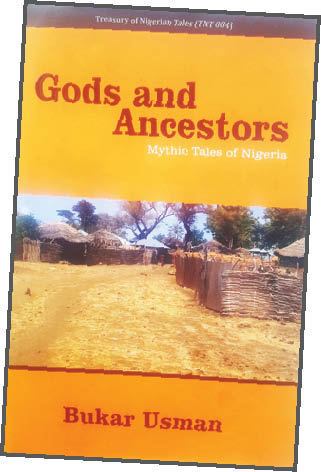Book Review: Gods and Ancestors
Bukar Usman’s exciting compendium of mythic tales of Nigeria We grew as children to stories, myths and legends. One of them was of the old man who lived alone on the moon, and on occasions could be seen bearing her load of firewood. Forget that there are no trees on the moon, or humans for […]

Gods and Ancestors
- Bukar Usman’s exciting compendium of mythic tales of Nigeria
We grew as children to stories, myths and legends. One of them was of the old man who lived alone on the moon, and on occasions could be seen bearing her load of firewood. Forget that there are no trees on the moon, or humans for that matter, but so real were these stories in our minds that we actually, on occasions, saw this woman on nights of full moon. Our moonlight storytelling traditions were much cherished entertainments, but most crucially, vehicles for transferring moral values that have defined who we are. They were the schools our fathers and their fathers before them went for moral and social instructions.
What those stories did for us was to give us the license to imagine the impossible, to connect something from our pasts, our myths and legends to a future that we did not realise at the time was coming, where mythical gods and legendary figures would be better packaged and sold as franchise across the world, generating revenues enough to power nations.
Today’s children are groomed on the packaged big screen versions of Scandinavian gods Thor and the Asgardians. Time has eviscerated our story telling traditions, and since we have not yet learned to bring our myths and legends into the 21st century, as Hollywood has done for western myths, these vast body of knowledge built over centuries and transferred from generation to generation is in grave danger of extinction.
In this regard, the enormity of the task carried out by the prolific researcher and writer, Dr. Bukar Usman in collecting and compiling the mythic tales of Nigeria in the book Gods and Ancestors cannot be overemphasized.
This book, a part of his Treasury of Nigerian Tales, is a compendium of 213 mythical tales from all over the country collected by a team of researchers with the support of the Bukar Usman Foundation. What Dr Usman, the editor, did was to categorize these stories into four; Creation and Cosmic Myths, which captured the essence of the mythical relationships between the various cosmic bodies and entities and various elements, like earth sky and fire.
The Group Origin Myths and Chronicles, the second section, naturally featured various origin stories from various tribes in Nigeria. But in this category also, one would find an eclectic collection of myths such as Why the Indigenes of Ode Aye Do Not Eat Chicken, amongst origin stories for certain festivals, compounds and the likes. One of the most interesting myths here why nursing mothers in the Ooni’s palace have to endure saltless food for seven days.
While some of these stories are hilarious, they attempt to provide justification for certain cultural practices that have existed for so long not many people know how they came about or why they are being practiced.
Oracular Myths and Chronicles, the third section, documents the origin of certain cultural practices and sacrifices. It consists of numerous morality stories and in many instances is peppered with numerous conflicts, between friends, as in how goats were domesticated, and between gods and their priests. There are some spectacular fallouts here as this section chronicles a good number of rebellious mythical figures, some of them already slipping into the shadow of lost tales.
In the section Legendary Heroes and Heroines, Dr. Usman assembles tales of the popular figures from myths and legends. The Ozidis, the Igala princess Inikpi, who like Moremi, sacrificed herself for her people and lesser known figures like Laoye Farikorun, who fought the first world war and returned, in a story that reads like a magical realist dream.
Dr. Usman closes his book with Various Communal Chronicles in which certain common practices or beliefs are recounted through myths and anecdotes. Some sof them like ‘Why Tivs Don’t Eat Dog Meat’ are attempts to justify certain cultural beliefs while unwittingly demonstrating the bonds that have existed between humans (Usha the TV prince who committed suicide because his dog was killed and eaten) and animals that have played a huge part in human evolution. Or how an encounter with perhaps a non-poisonous snake made the Naayeri people venerate snakes and never kill them. This section also includes interesting accounts about how the Tiv adopted black and white as their colours, and yes, it has something to do with a zebra apparently.
These 213 myths are short, some only a couple of paragraphs long, but they contain the essence of peoples’ stories and heritages. And even if they defy logic today, which is why they are called myths in the first place, they offer glimpses into the reasoning of a people in prehistoric times. In them there are rich source material for others in the creative industry, like filmmakers, writer and researchers. Hollywood is making lots of money exploring its myths, presenting it for a new generation. A popular adage has it that the only difference between Thor and Sango is packaging.
Dr. Usman and his foundation have done an amazing work compiling these myths, which otherwise would have been lost completely if the last people who know these stories pass on. Gods and Ancestors: Mythic Tales of Nigeria is a treasure trove.
